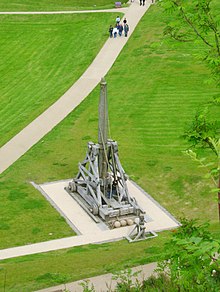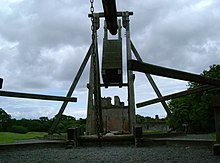Warwolf

The largest trebuchet ever built was called Warwolf or Ludgar (from French Loup de Guerre ; Latin Lupus guerrae ) .
Historical warwolf
The warwolf was built on behalf of King Edward I of England when he besieged Stirling Castle during the Scottish Wars of Independence in 1304 ( see Siege of Stirling Castle ).
The war machine is said to have been so big that, when dismantled, it held thirty truckloads. It took five master carpenters and 49 other workers three months to assemble. The Scottish defenders of Stirling Castle were so intimidated by the sight of the Warwolf that they offered their surrender, which Edward I refused before he had not tested Warwolf. On Monday, Saint Margaret's Day (July 20, 1304), Warwolf finally fired some 300 pound (140 kg) bullets with great precision , which breached the curtain wall of Stirling Castle and caused considerable damage to the castle buildings. The defenders' surrender was then accepted.
Technique of the trebuchet
Trebuchets were fixed or mounted on wheels and could throw stone balls over 300 m. For this purpose, an appropriate counterweight was mounted on the "limb", which either consisted of a basket-like structure filled with stones or sand / earth or of lead or other metallic plates. Trebuchets could be used as an attack weapon, but also as a defensive weapon, for example in castles.
In the siege of Stirling Castle in 1304, lead was preferred as a counterweight.
Experimental historical research

A few years ago an archaeotechnical experiment was carried out in the immediate vicinity of Urquhart Castle . Two large trebuchets called "Warwolf" were recreated to test the effect and functionality of these weapons - there are only a few records of this weapon (mostly only contemporary pictures with incorrect dimensions), so that one could not ultimately clarify before this experiment how it could have worked exactly. Two models were built:
- Version 1 had a basket-like counterweight (see photo Warwolf Caerlaverock).
- Version 2 had metal plates as a counterweight (see photo Warwolf Urquhart Castle). This model remained with Urquhart as a display object.
Both versions managed to sustainably damage a castle wall replica, which was built especially for this experiment, about 200 m away. The aiming as well as the setting of the throwing distance could be done quite precisely by modifications to the devices (pin deformation of the bullet loop and the guide cannula for the bullet loop).
By systematically bombarding the same spot, the wall would ultimately have collapsed.
The experiment also showed that the machine with the basket counterweight proved to be the better one for combat operations, because the counterweight in the form of stones or earth was much easier to tare than the model with the plate weights. In addition, the latter had to be laboriously and time-consuming to pour in the battles - earth and stones, however, were always and constantly available and could easily be put into the basket.
literature
- Michael Barnes: Secrets of lost Empires. Reconstructing the Glories of Ages past. BBC Books, London 1996, ISBN 0-563-37118-8 (The TV series book).
- Michael Barnes: Warwulf. Documentation for the SWR, 2000, broadcast in the program of the NDR. Original documentation: Secrets of Lost Empires - Trebuchet. WBGH Boston (Nova), Boston MA.
- Julian Humphrys: Enemies at the Gate. English Castles Under Siege from the 12th Century to the Civil War. English Heritage, 2007, ISBN 1-9056-2426-3 , p. 29.
Individual evidence
- ↑ The large largest trebuchet ever built: Warwolf in the Siege of Stirling Castle. In: thefactsource.com. Retrieved March 25, 2020 (English).
- ^ Joseph Stevenson (ed.): Documents Illustrative of the History of Scotland from the Death of King Alexander the Third to the Accession of Robert Bruce. 1286-1306. Volume 2, HM General Register House, Edinburgh 1870, p. 481.
